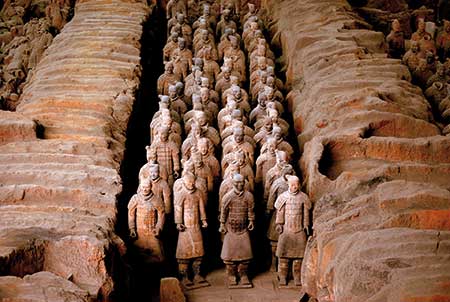China
你好, 中国 - From Workbench Economy to a Leader in Science and Technology (Pt II)
Career strategies for young European scientists
by Ralf Schreck, Labtimes 01/2014
Page 1 | Page 2 | Page 3
A Chinese Ivy League
China’s ambitions to have research universities on equal footing with the MIT, Harvard or Cambridge in future gained entry into various strategic papers of the Ministry for Education, including the “Plan to Revitalize Education for the 21st Century” (1998) or the “Educational Action Plan towards the 21st Century” (2007). On top of the Project 211 the Project 985 was installed and named after its announcement date in May 1998.
Not many details of the 985 programme are available but in the initial funding phase of the project (1998-2003) close to ten universities were included and received a total of about €1.3 billion. At present, 39 universities are listed as 985 universities and receive extra support by the central and local governments. C9, a consortium of the nine initial 985 universities, was founded in 2009. Agreements between the C9 members were, for example, signed for flexible student exchange programmes and cooperative postgraduate training. Besides Peking University and Tsinghua University in Bejing these are the following institutions: Fudan University and Shanghai Jiao Tong University in Shanghai, the Zhejiang University, the Nanjing University, the University of Science and Technology of China and the Xi’an Jiao Tong University in the greater Yangtze river delta and the Harbin Institute of Technology, which has three campuses, separated by a few hundred kilometres.
The C9 alliance was referred to as the Chinese Ivy League, in reference to the Ivy League, a group of eight old and preeminent US universities. Thomson Reuters investigated the research output of the C9 universities between the years 2000 and 2010. It turned out that the C9 universities, which account for about 3% of China’s researchers, generated more than a fifth of China’s total publication output and drew more than 30% of China’s citations. In October of last year, representatives of the C9 but also from three additional groups of research universities, the Group of Eight Australia (Go8), the League of European Research Universities (LERU) and the Association of American Universities (AAU) met to pave the way for future cooperations among global leading research universities. During the meeting the Hefei Statement was issued, which put forward ten characteristics of contemporary research universities, including the dedication to the highest standards of research integrity and associated ethical obligations.
Goose-stepping to the top
Major global university rankings provide individual profiles on the best Chinese universities, which are often more informative and up-to-date than the official English websites. By skimming various rankings, it turns out that China has made a great leap forward in the last decade and that the Projects 211 and 985 were at least successful in placing more Chinese universities among the world’s best. For example, whereas the Academic Ranking of World Universities (ARWU) listed only 36 Chinese Universities among the 500 globally leading institutions in 2004, 88 universities are represented a decade later. In the latest QS World University Ranking all 25 itemised Chinese universities receive funding from the 211 Project. The Universities of Peking (rank 46) and Tsinghua (rank 48) were among the Top 50 and the University of Fudan made it among the leading 100 institutions. In the five subcategories of the faculty ranking, between four and six Chinese universities are in the group of the first hundred with exception of the Life Sciences, where no Chinese university emerged. Noteworthy, that the Tsinghua University was the world’s 12th best in the subcategory Engineering and Technology.
Becoming more important are rankings, which consider the regional context or the economic status of a given country. Those help to identify trends and upcoming universities that right now do not surface in global rankings and allow to compare individual efforts of a nation among its peers. For example, in the QS Asia Ranking, 37 Chinese Universities are among the leading 300 institutions. Peking University at rank five was only outnumbered by the two main universities of Hong Kong, the National University of Singapore and the Seoul National University. For the first time, also two rankings with a focus on emerging economies were published last year. Whereas the QS Ranking concentrated on countries collectively designated as BRICS (Brazil, Russia, India, China and South Africa), the ranking published by Times Higher Education (THE) was more comprehensive and analysed ten advanced emerging and twelve secondary emerging nations. Among the Top 100 institutions were 23 Chinese, 21 Taiwanese and 10 Indian universities in the THE Ranking, whereas 40 Chinese universities shined up in the QS Ranking. This underpins the eminent role of China’s leading universities among the Asian and BRICS countries and might help to draw at least the attention of students and scientists from those countries.
Cash incentives to drive science
Institutional rankings and scientific evaluations nowadays largely depend on the quality, quantity and impact of publications as well as the acquisition of research funds. Over the years, the Chinese research system has increasingly focused on publications in international journals that are covered by the Thomson Reuters Science Citation Index Expanded (SCIE) with more than 8,600 entries, the Elsevier Engineering Index or the Index to Scientific and Technical Proceedings.
The German Fraunhofer Institute for Systems and Innovation Research (ISI) investigated in detail the publication activity in the SCIE database in the context of Chinese science and technology policy from 1977 to 2012. It turned out that publications increased tremendously with average annual growth rates of 20%. Right now, China’s share of articles published in SCIE indexed journals is second best in the world, while it is ranked fourth worldwide for its number of citations. However, when citations per paper since 1980 are considered, China is ranked just 78th. This may be explained by the fact that the number of articles in the 80s and 90s was too modest to draw a large number of citations. Moreover, the majority of articles is published in low-impact SCIE journals, which may not receive too much attention by the scientific community. In 2012, the universities contributed to more than 82% of China’s SCIE publications. As key drivers of the massive increase in China’s SCIE papers the authors of the ISI analysis ascribe the substantial growth of investments into science as well as the widespread utilitarian practice in China. Instead of doing science for science’s sake, its practical purpose under economic or politic considerations is overvalued. For the individual academic researcher this means that SCIE papers secure his promotion and research grants. In addition, he may benefit from a hefty salary bonus on top of his basic salary. In a country that rewards its academics with one of the worldwide lowest wages, cash incentives besides moonlighting have become, for many, important sources to make a living.
Reward for a Nature paper
Salary enhancements for SCI publications were first made available by the Nanjing University as early as 20 years ago. Initially, a bonus of €120 (at today’s exchange rate) was paid per author of a paper published in SCI journals. In the meantime, the rewards have moved up substantially. The system of monetary rewards is made transparent by some institutions. For example, the Zhejiang Medical University published a list of incentives a few years ago. The rewards were justified by the goal to “fully mobilise the enthusiasm of teachers and technical personnel and promote scientific and technological work, increasing the university’s competitiveness”. Bonuses included up to €24,000 for a paper published in Nature or Science, a graduated scale of payments for SCI indexed journals related to their impact factor, €600 for patents, up to €36,000 for novel registered drug candidates and chemicals, and up to 1% of the total amount of project funding granted by specific funding organisations and programmes. Other institutions apply the following calculation method: one plus the impact factor of the journal (to acknowledge also publications with an impact factor below 1) multiplied by €1,200. Accordingly, an article in the New England Journal of Medicine with an impact factor of 51 racks up about €60,000.
No need for experiments
The pressure to publish in SCI indexed journals and beyond has created a flourishing black market for selling authorships and ghost writing. In a News Focus of Science entitled “China’s Publication Bazaar” from November last year, Mara Hvistendahl reported on a five-month undercover investigation into paper-selling companies in China. After an anonymous tip-off, such companies were easy to find with the help of specific Chinese search engines by entering, for example, “SCI publication”.
Twenty-seven companies were approached and asked for further details. It turned out that the whole “food chain” is involved: from individuals or companies offering such dubious services, over PhD students and senior scientists as customers, along to publishers and editors turning a blind eye. A current practice is to sell co-authorships on papers after they have already been accepted, by asking to include an unintentionally omitted scientist or on papers during revision by adding a co-author, providing supposedly the missing data asked for by the reviewers. Service fees charged by the companies for a guaranteed authorship ranged anywhere between €1,200 and €20,000. On offer were also publication guarantees for manuscripts written by the scientists themselves, the full translation and publication of articles into English after they have already been published in Chinese journals as well as ghost writing review and meta-analysis papers without the need to generate any original data.
Other high profile cases involving plagiarism as well as data fabrication and falsification were made public in leading scientific journals and have cast a very dark shadow over China’s research integrity. For example, after the discovery of extensive fraud, the Wiley journal Acta Crystallographica Section E had to retract not less than 70 papers in 2009 with contributions of just two Chinese scientists: chemist Hua Zhong and engineer Tao Liu from Jinggangshan University in Jiangxi. An additional 39 articles by Chinese authors were retracted by the same journal a year later. Scientists of Jinggangshan University, which is not a 211 university, were again involved in about half of the retractions. Whereas Zhong and Liu were fired, the three scientists involved in the latter cases continue to hold positions of dean and vice-dean at their faculties and were not removed. In the same year, the plagiarism-detecting tool CrossCheck was applied for the first time in China and it turned out that about a third of submissions to the Journal of Zhejiang University, a key academic journal in China, contained falsified or fabricated data.
Page 1 | Page 2 | Page 3
Last Changed: 05.02.2014







